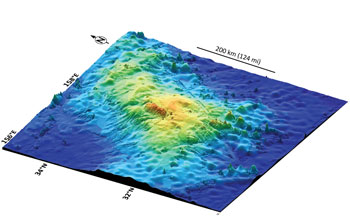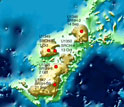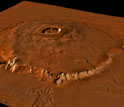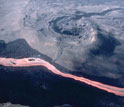Massive underwater shield volcano rivals biggest in solar system.-
 Credit and Larger Version |
September 6, 2013
The summer blockbuster movie Pacific Rim told a fanciful tale of giant monsters rising from the deep in the middle of the Pacific Ocean.
Now, scientists have confirmed that the northwest Pacific is home to a real-life giant of a different type: the largest single volcano yet documented on Earth.
Covering an area roughly equivalent to the British Isles or the State of New Mexico, Tamu Massif is nearly as big as the giant volcanoes of Mars, placing it among the largest in the solar system.
"This is an amazing discovery, and overturns previous conclusions that Earth cannot support the development of such giant volcanoes because it lacks a thick and rigid planetary lithosphere," says Jamie Allan, program director in the National Science Foundation's Division of Ocean Sciences, which funded the research.
"Much remains to be discovered about our planet," says Allan, "with scientific drilling offering a means of observation and discovery into otherwise inaccessible parts of the Earth."
Located about 1,000 miles east of Japan, Tamu Massif is the largest feature of Shatsky Rise, an underwater mountain range formed 145-130 million years ago by the eruption of several underwater volcanoes.
Until now, it was unclear whether Tamu Massif was a single volcano, or a composite of many eruption points.
By integrating several sources of evidence, including core samples and data collected on board the JOIDES Resolution, scientists have confirmed that the mass of basalt that constitutes Tamu Massif did indeed erupt from a single source near the center.
The results appear today in a paper in the journal Nature Geoscience.
"Tamu Massif is the biggest single shield volcano ever discovered on Earth," says lead paper author Will Sager of the University of Houston.
"There may be larger volcanoes, because there are bigger igneous features out there such as the Ontong Java Plateau. But we don't know if these features are one volcano or complexes of volcanoes."
Tamu Massif stands out among underwater volcanoes not just for its size, but also its shape.
It is low and broad, meaning that the erupted lava flows must have traveled long distances compared to most other volcanoes on Earth.
The seafloor is dotted with thousands of underwater volcanoes, or seamounts, most of which are small and steep compared to the low, broad expanse of Tamu Massif.
"It's not high, but very wide, so the flank slopes are very gradual," Sager explains.
"In fact, if you were standing on its flank, you would have trouble telling which way is downhill.
"We know that it is a single immense volcano constructed from massive lava flows that emanated from the center of the volcano to form a broad, shield-like shape. Before now, we didn't know this because oceanic plateaus are huge features hidden beneath the sea. They have found a good place to hide."
Tamu Massif covers an area of about 120,000 square miles.
By comparison, Hawaii's Mauna Loa--the largest active volcano on Earth--is a mere 2,000 square miles, or less than 2 percent the size of Tamu Massif.
To find a worthy comparison, one must look skyward to the planet Mars, home to Olympus Mons. That giant volcano, which is visible on a clear night with a good backyard telescope, is only about 25 percent larger by volume than Tamu Massif.
The study relies on two distinct yet complementary sources of evidence: core samples collected on Integrated Ocean Drilling Program Expedition 324, which tested plume and plate models of ocean plateau formation at Shatsky Rise in the northwest Pacific Ocean in 2009, and seismic reflection data gathered on two separate expeditions of the research vessel Marcus G. Langseth in 2010 and 2012.
The core samples, drilled from several locations on Tamu Massif, showed that thick lava flows up to 75 feet thick characterize this volcano.
Seismic data from the Langseth cruises revealed the structure of the volcano, confirming that the lava flows emanated from its summit and flowed hundreds of miles downhill into the adjacent basins.
"This finding gives us new insights about oceanic volcanism, the way in which oceanic plateaus form, and the operation of the mantle-crust system," Sager explains.
"Volcanologists debate about the eruptive centers of what are called large igneous provinces. I think most would tell you that they probably come from multiple, distributed fissure eruptions.
"But apparently not at Tamu Massif."
-NSF-
Media Contacts Cheryl Dybas, NSF (703) 292-7734
cdybas@nsf.gov
Matthew Wright, Consortium for Ocean Leadership/IODP (202) 448-1254
Matthew Wright, Consortium for Ocean Leadership/IODP (202) 448-1254
mwright@oceanleadership.org
Karen Riedel, TAMU (979) 845-0910
Karen Riedel, TAMU (979) 845-0910
Related WebsitesNSF Award: Collaborative Research: Geophysical Constraints on Mechanisms of Ocean Plateau Formation from Shatsky Rise, Northwest Pacific:
The National Science Foundation (NSF) is an independent federal agency that supports fundamental research and education across all fields of science and engineering. In fiscal year (FY) 2012, its budget was $7.0 billion. NSF funds reach all 50 states through grants to nearly 2,000 colleges, universities and other institutions. Each year, NSF receives about 50,000 competitive requests for funding, and makes about 11,500 new funding awards. NSF also awards about $593 million in professional and service contracts yearly.
Useful NSF Web Sites:
NSF Home Page:
NSF Home Page:
http://www.nsf.gov
NSF News:
NSF News:
http://www.nsf.gov/news/
For the News Media:
For the News Media:
http://www.nsf.gov/news/newsroom.jsp
Science and Engineering Statistics:
Science and Engineering Statistics:
http://www.nsf.gov/statistics/
Awards Searches:
Awards Searches:

Sites drilled by scientists aboard the JOIDES Resolution on Expedition 324/Shatsky Rise.
Credit and Larger Version

Geoscientist Will Sager, left/center, waits to inspect a core sample drilled on Expedition 324.
Credit and Larger Version

Researcher Margaret Hastedt labels pieces of core collected during Expedition 324.
Credit and Larger Version

Olympus Mons (Latin for Mount Olympus) is a large shield volcano on the planet Mars.
Credit and Larger Version

Mauna Loa has been called the largest volcano on Earth in volume and area covered.
Credit and Larger Version
The National Science Foundation (NSF)
Guillermo Gonzalo Sánchez Achutegui

No hay comentarios:
Publicar un comentario